
 |
|
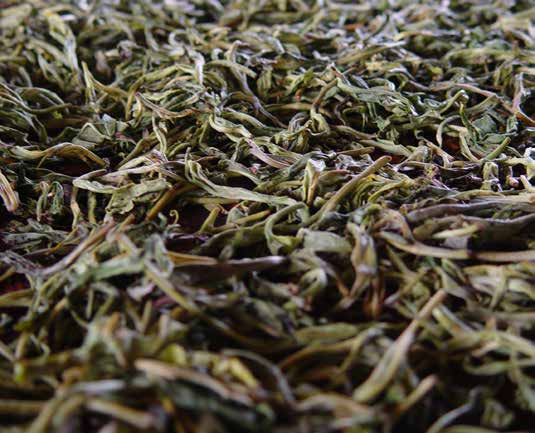
Puerh is unique amongst all the genres of tea because the importance of the raw material far outweighs any processing skill. The quality of most oolongs, for example, is determined as much by the source of the leaves as by the skill of the one processing the tea. The value of puerh, on the other hand, is ninety percent in the trees. There are many kinds of tea trees in Yunnan and the source determines the value of the tea. What village a tea comes from and which trees will decide its value, in other words. Of course, there is also plenty of dishonesty in the puerh world: material picked in one region and then taken to a more expensive one to be sold as native tea, young trees sold as old trees, etc. This means producers and consumers have to be able to distinguish the differences between regions and types of leaves.
Puerh trees can roughly be divided into two main categories, though it is useful to understand some of the subdivisions as well: old-growth (gu shu, 古樹) and plantation tea (tai di cha, 台地茶). Oldgrowth tea is by far the better of these two. This refers to older trees. There is some debate about what constitutes "old-growth" since tea trees in Yunnan can range from dozens to thousands of years old. Arbitrarily, we think that when a tea tree becomes a centenarian (100 years), it can rightly be called "old-growth". Old-growth tea can then be subdivided into trees that are wild or those that were planted by people. Though planted by man, the latter are often indistinguishable from the former as they are both found in small gardens in the heart of the forest. In fact, you would have difficulty picking the trees out from their surroundings without the help of a guide. Another subdivision could be called "ecologically-farmed old-growth", which refers to old trees planted in gardens closer to villages and/or homesteads. Some people also like to have a category for 1,000+year-old trees as well, calling them by that name or maybe "ancient trees".
Plantation puerh (tai di cha) is far inferior and often not organic. The trees there might even be several decades old, but they aren't Living Tea, and lack many of the qualities that make puerh so special, as we discussed in our article about this month's tea.
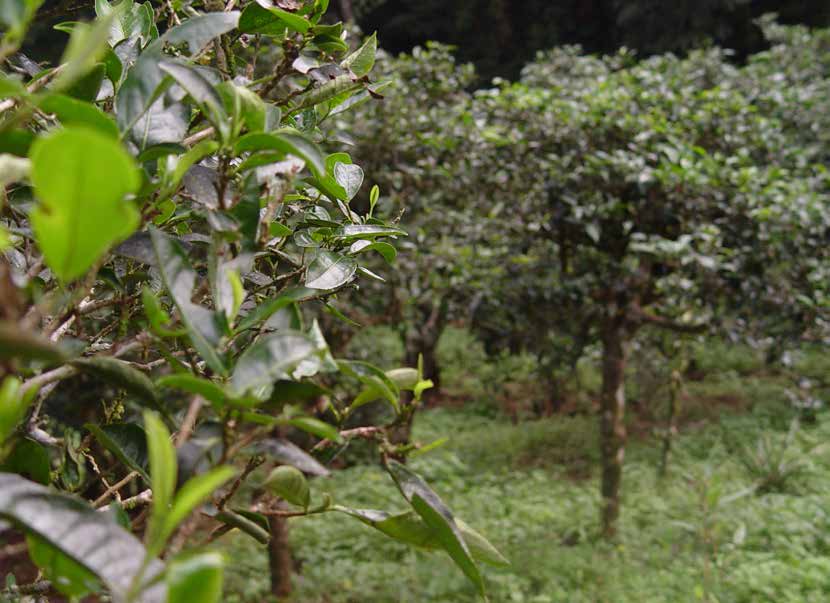
All puerh tea begins with mao cha (毛茶), which translates as "rough tea". Mao cha refers to the finished leaf as it leaves the farm to be sold directly to factories small and large, or independently at market. Tea at this stage has been plucked by hand, wilted, fried to remove the raw flavor (called "sa chin" 殺青), kneaded (ro nien, 揉捻), and dried. These processes need to occur almost immediately after the tea has been plucked, which is why they are done directly at the farm rather than at the factory.
Most varieties of tea include all the same stages of processing as puerh, though unlike puerh, the final processing often ends there and the loose-leaf tea is then packaged right at the farm. (Some oolongs were traditionally finished at shops, as well. The shop owners would do the final roasting to suit their tastes.) Puerh, on the other hand, often travels to a factory for final processing: compression into cakes if it is raw, sheng puerh or piling and then compression if it is ripe, shou puerh.
Some varieties of puerh are also destined to become loose leaf. At the start, that means that they remain "mao cha", but once they are aged, they are technically no longer "rough tea". So an aged, loose-leaf puerh shouldn't really be called "mao cha".
Traditionally, these loose teas were the ones that were grown at smaller farms that didn't have contracts with any factory - often from so-called "Border Regions" where Yunnan borders Laos, Vietnam or Myanmar. Such teas were then sold at market, traded between farmers or bought and stored by collectors. You can't be certain, however, that a loose-leaf puerh is a Border Tea, as the big factories also packaged and sold some of their teas loose, though not as much as compressed tea. Although some of the tea that was sold loose was fine quality, most of it was considered inferior.
We have a huge collection of loose-leaf puerh tea here. In fact, we have so much that we have also become collectors of rare antique jars to store it all in. Loose-leaf puerh, no matter how old, is always cheaper than puerh compressed into cakes. One reason for this is that the cakes have an easily-verified vintage. Though there are fakes, experts have developed systems of identifying them, using a combination of factors from a kind of "wrapperology", which identifies characteristic marks, color changes, etc., in the printing of the wrappers to the cake itself - its shape, leaf color or size, compression, etc. On the other hand, very few aged loose-leaf teas are pure. Most of them are blends. Some were blended during production, though more often, tea was added later on to increase the quantity of an aged tea. Sometimes blends of wet and drierstored teas, or even sheng and shou are mixed to make a tea seem older than it is. When drinking aged loose leaf puerh, it is a good idea to only rank them relative to other loose-leaf puerhs, rather than believing in the date the merchant has given. While some loose-leaf puerhs do have a distinct vintage, most are blends. Looking at the wet leaves after steeping will also verify this.
Beyond that, cakes have been found to have more Qi than loose leaf puerh, so that if the same tea were left loose and processed into a discus (bing, 餅), for example, and then aged for thirty years, the cake would have more Qi than the loose leaf. Having done several experiments where we stored the same exact tea from the same farm in both loose leaf and cake form, we can say for sure that the compressed teas age better, and not just in terms of Qi. They are better in every way: flavor, aroma, etc. They also age faster and more evenly. One possible reason for this is that the steam used to compress the cakes seals the bacteria in, and the inner moisture creates a better environment for them to do their work. Still, despite the fact that cakes are better, loose-leaf teas are often great deals since they are much cheaper than cakes of the same age. It's like choosing a more affordable antique teapot with a chip under the lid versus a perfect, very expensive one. Depending on your budget, the former may be the better choice.
Puerh tea is sometimes put into the black tea category (remember, this isn't red tea, which is mistakenly called "black tea" in the West), but it should actually have a category all its own. Traditionally, all puerh was fermented before consumption, whether artificially in the case of shou or naturally over time in the case of sheng. As we've mentioned elsewhere, tea lovers back in the day considered new, sheng puerh as "unfinished" and rarely drank it, except to see how it was aging. Therefore, all puerh tea was fermented and fit nicely into the black tea genre, which is categorized by post-production fermentation.
These days, however, much more sheng puerh is consumed young than old. And since sheng puerh vastly overshadows shou in quantity and in historicity (shou only dates back to the sixties or seventies), sheng obviously typifies puerh tea.
One solution to this change in tea production/consumption would be to put young, sheng puerh in the green tea category and aged sheng along with shou in the black tea category. But that seems much more confusing than just giving puerh tea its own genre. We think that since it's the oldest tea, and from the birthplace of all tea, puerh deserves its own genre!
The freshly plucked leaves are carried back to the house or village and gently spread out on bamboo mats to be slightly wilted before they are heated to remove the raw flavor. The purpose of wilting the leaves is to slightly reduce the moisture content in the leaves so that they will be more pliable and less likely to be damaged when they are heated. This process must be watched carefully so that the leaves do not oxidize more than is absolutely necessary. For that reason, wilting typically takes place outdoors and indoors. The tea is withered outdoors for some time and then placed in a well-ventilated room, often shared by members of a particular farming village.
The heating process/firing (sa chin) is literally performed to remove the raw flavor of the tea leaf. This occurs in the production of most all kinds of tea (except white tea, which categorically skips this process). In Yunnan, the heating process is still often done by hand in large woodfired woks. The temperature must remain constant and the leaves have to be continuously turned to prevent any singeing. In larger farms, though not often in Yunnan, this is done in large barrel-like machines that spin around like a clothes drier. With puerh, however, the firing is still done by hand, once again lending tradition and wisdom to the puerh process. Workers sift the leaves around in circular motions ensuring that they never touch the wok for longer than a blink. Through generations of experience the farmers can tell by appearance and feel when the leaves are sufficiently cooked, and their timing is as impeccable as any time/temperature-controlled machine elsewhere. Scientifically, the process is removing certain green enzymes within the leaf that lend it the raw flavor, which in some varieties is too bitter to be drunk. As we'll discuss later, the sa chin of puerh is less-pronounced than in many other kinds of teas.
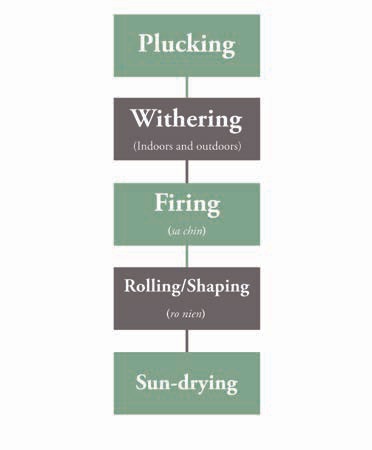
After the leaves are fried they
are kneaded (ro nien). This process
also occurs by hand on most puerh
farms or villages near old trees. A
special technique is used to knead
the leaves like dough. This bruises
the leaves and breaks apart their cellular structure to encourage
oxidation, and later fermentation (fa xiao,
發酵), which will occur through the
various methods (explained in the
box about sheng and shou puerh on
the opposite page).
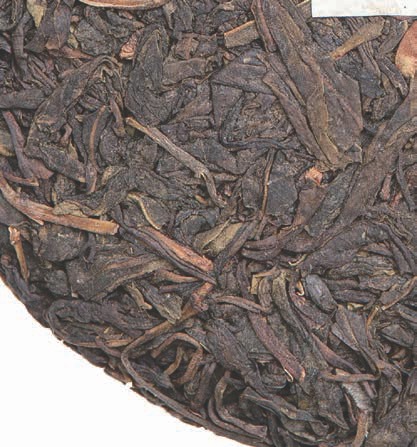
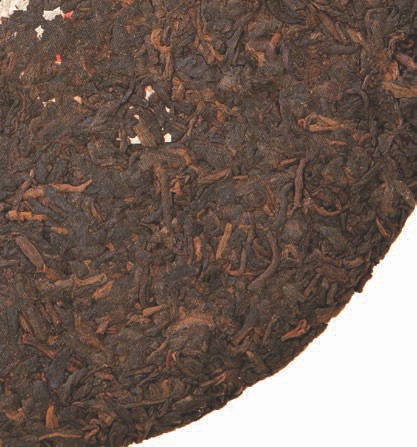
Green puerh (sheng 生), often called "raw" or "uncooked", is produced without any fermentation (fa xiao) during the production or compression of the cakes. The fermentation of these cakes occurs slowly through an aging process that takes seventy years to reach complete maturity. These sheng cakes are by far the more valuable of the two varieties of puerh and represent the traditional method of puerh production.
Sheng puerh is said to be fully mature at around seventy years. Of course, we can enjoy aged puerh at any time, and each age has its own charm. Young puerh has characteristics unlike any tea, as does teenage puerh, middle-aged and fully-matured. Nowadays, as vintage sheng puerh gets more and more expensive, many people consider thirty-year-old tea to be very old. Still, there is a reason why puerh experts have always said seventy years was full maturity: after around seventy years, the changes in the physical characteristics of the puerh will slow down enough to say they have stopped changing. In other words, the tea liquor isn't going to get any darker, and the flavors, aromas and mouthfeel of a tea this old are changing so slowly, you will have to find a much older specimen to see the differences. Of course, all things equal, the older the better.
As puerh ages, the rate of change decreases, so the difference between a five and ten-year-old puerh is more pronounced than the difference between a thirty and forty-year-old tea. After seventy years, the tea has reached the point that its leaves won't get any darker and the liquor will look the same as a one-hundred-year-old tea, though the latter may have more Qi and a slightly different flavor profile.
Black puerh (shou 熟), often called "cooked" or "ripe", is produced through a processes that ferments (fa xiao) the tea to varying levels before it is compressed. Called "wo dui (臥堆)" in Chinese, this step in puerh production is akin to composting. The tea is piled, moistened and then often covered with a thermal blanket to increase internal heat. Sometimes previously fermented tea is introduced to promote certain bacterial growth. The process could be stopped at any time, though a typical, "full" fermentation runs from forty-five to sixty days. Different factories may adjust the length of time that a tea is piled based on their recipes, the kind of tea they use, or the desired level of fermentation. Most older shou tea was fermented only partially, whereas the majority of shou produced today is stronger, fully fermented tea.
Ripe (shou) puerh can never attain the quality of flavor, aroma or Qi as a properly aged sheng puerh. The process of piling puerh to artificially ferment it was developed in the late sixties and then licensed for commercial production in 1973, which is usually the date most books will cite as the beginning of shou puerh. Factories were looking to mimic the qualities of aged sheng in less time. Of course, they were not successful. What they did create, instead, was a whole new category of puerh tea to be evaluated and enjoyed by itself, and according to its own criteria of quality, rather than comparing it to sheng puerh.
Ripe tea doesn't age the same as sheng. If the tea was partially fermented, however, it will age. Since many early ripe teas were only partially fermented, they can even be sold as sheng to the uninitiated. Fully-fermented ripe teas tend to mellow out over time, loosing some of the rough, "pondy" or ammonia flavors associated with such a long period spent piling.
It takes skill and method to achieve a gentle bruising without tearing the leaves. We have personally tried this in Yunnan and Taiwan, and found it is very difficult to achieve. We invariably tore up the leaves. The farmers, however, can go through the movements with surprising speed.
Finally, after the mao cha has been kneaded and bruised it is left to dry in the sun. Once again this process must be monitored carefully to prevent any unwanted oxidation or fermentation from occurring. Usually, the leaves are dried in the early morning and late evening sun, as midday is too hot. They will move the leaves into the same well-ventilated room used earlier for wilting during the hot hours of the day. The leaves will be inspected hourly and when they have dried sufficiently, they will be bagged and taken to the factory to be processed, or to market to be sold as loose leaf.
The two most distinguishing aspects of puerh production are the sa chin and the sun drying. The firing of puerh tea does arrest oxidation, as in all tea, but it is usually less pronounced than other kinds of tea, leaving some of the enzymes in the tea alive, as they help promote fermentation. Then, after firing and rolling, puerh is sun dried. This gives it a certain flavor, texture and aroma and helps further the natural vibrations present in the tea. Not all puerh is processed in this way, especially with all the innovation and change in the modern industry - though, ideally, we want tea made in traditional ways.

Once the leaves are processed, they will often go through their first sorting (fan ji). A second sorting will occur later at the factory itself. This sorting is to remove unwanted, ripped or torn leaves, as well as the leaves that weren't fired or rolled properly. At this stage, the factory/ producer may ask the farmer to sort the leaves according to size, called "grade". This practice is becoming rarer, however, as the prices of oldgrowth puerh increase. Nowadays, farmers sell most everything. Sometimes, they don't even sort out the broken or mis-processed leaves.
Upon arrival to the factory, the mao cha goes through its second sorting (fan ji). This is often done by hand even at the larger factories, though some have large winnowing machines. And most have strict rules controlling the diet of the sorters. Tea is an extremely absorbent leaf and will be altered by any impurities. Sorters therefore shouldn't eat chili, garlic or onions. Nor can they drink alcohol the night before a sort, as it will be secreted through their skin and contaminate the leaves. The sorting that occurred on the farm was more cursory and based solely on leaf size or "grade". This second sorting is more detailed and thorough. The leaves are distinguished not only by their size, but also by their quality, type (old or young growth, which mountain they came from, etc.), and other criteria that are constantly changing. Larger factories often have mao cha arriving from all over Yunnan and therefore employ experts to monitor all sorts of conditions to determine which leaf size, which locations, etc., will have a good harvest that year. More and more, factories are targeting collectors by creating limited edition sets, with cakes from certain mountains, for example.

There is a lot of discussion nowadays about the differences between single-region and blended puerhs. For the last fifty years, most all puerhs were blends. The factories would collect the mao cha from various regions and then blend them in ways they thought improved the tea: choosing strength and Qi from one region, blended with sweetness and flavor from another, etc. In this way, cakes would be more balanced. In the last fifteen years, there has been a trend towards single-region cakes, and with it the idea that such tea is more pure. It should be remembered that all old-growth puerh is actually a blend, since no two trees are the same. So even tea from a single mountain will be a blend of different teas. If you are sensitive enough, you can even distinguish the leaves from the eastern and western side of a single tree, since they receive different sunlight. There are merits to both kinds of cakes, and it seems pointless to say that one is better than the other in general. It would be better to talk about specific teas, as a certain blended cake may be better than a given single-region cake or vice versa.
The trend towards boutique, private and single-region cakes has also changed the way that puerh is produced. For example, some cakes are made on site and completely processed by the farmers themselves. Most tea, however, still travels to factories for sorting (blending) and compression. What was once one of the simplest teas, at least as far as processing goes, has now become complicated by the vast industry that has grown up around it.
Mao cha can sit in a factory for a long or short time, depending on many factors. In doing so, it technically ceases to be "rough tea". Sometimes tea is aged for a while and then piled to produce a nice, mellower shou tea than a new tea could produce. Other times the tea that was inferior and didn't make it into a cake, is then sold loose leaf later, and labeled "aged" to help market it.
Once ready, the leaves are carefully weighed and placed into cloth compression bags or metal pans. The texture of these bags can be seen imprinted on puerh tea if one looks closely. They are not used to package the tea, only in the compression process itself. They are made from special cross-woven cotton. Strangely, even the larger factories that we've visited still use antique-looking scales to do their weighing. Along with human error, this explains why even new cakes are often incorrect in either direction by a decimal of a gram (of course in aged tea this is usually due to pieces breaking off).
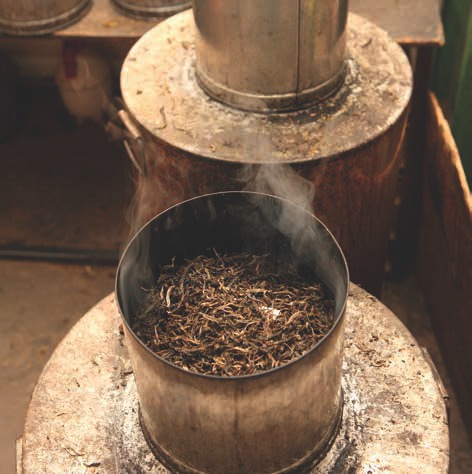
Steam is used to prepare the tea for compression. The steam is carefully controlled - mostly automatous in the larger factories - to ensure the leaves are soft and pliable, but not cooked or oxidized in any way. It is basically a process of slight rehydration. The steam softens the tea and the cloth in preparation for compression. Sometimes the steaming takes place before the tea is placed into the cloth, using metal pans instead. In a non-mechanized factory a wooden table is placed over a heated wok full of water. The steam rises through a small hole in the center. This is far more difficult than the automatic steam generators at larger factories because the temperature control is lacking and the leaves can end up being burnt. It requires the skill of generations to successfully steam the tea this way.
The compression process was traditionally done with stone block molds. The tea is placed in the cloth, which is then turned and shaped into a ball. The nei fei is added at this time - an "inner trademark ticket" compressed into the tea to establish branding. The cloth is then twisted shut and covered with a stone mold block. The producer would then physically stand on the stone block and use his or her weight to compress the cake. In some of the smaller family-run factories, puerh cakes are still created using this method. On our recent visit to Yunnan, we had the chance to make our cakes by dancing around on the stone molds, to the delight of the Chinese audience present. Larger factories often have machines for compressing their cakes, though some still produce some of their cakes in the traditional way. Some are hand-operated presses that require the operator to pull down a lever and press the cake into shape; others are automatic and occur with the press of a button. We even saw one machine that was capable of compressing twelve bings simultaneously.
After compression, the cakes are taken out of the compression cloths and placed on wooden shelves to dry. They are still slightly damp from the steam at this stage. Many larger factories have a separate room with tons of shelves lined with drying cakes. The cakes are monitored and often even stored on particular shelves that are numbered according to their processing time. Different types of puerh leaves and different shapes or levels of compression will affect the amount of time that is needed to dry the cakes, from hours to days and sometimes even up to a week. Some big factories use ventilation systems and/or fans to speed up the process.
When they are finished drying, the cakes are taken off the shelves to be packaged. Each generation of cakes has its own unique characteristics with regards to the wrapping paper, printing, style of Chinese characters, nei fei, etc. As we discussed earlier, there is a whole science of "wrapperology". Each decade brought revolutions in the printing process worldwide, so it seems obvious that the larger factories would change their printing methods. Also, the wrapping paper in particular is handmade, and a lot can be discerned via fibers, texture, and the appearance of the paper as well as the ink color. It is impossible to forge many of these paper and ink combinations and make them appear aged.
Discus-shaped cakes, called "bingchas" are individually wrapped in handmade paper and then bundled in groups of seven (qi zi, 七子) called tongs (桶). Each tong is wrapped in Bamboo bark (tsu tze ka, 竹子殼). Sometimes English articles mistakenly assume that these are bamboo leaves. Actually, bamboo trees shed their skin whenever they get bigger or sprout new stems. You can see this material covering the floor of any bamboo forest. The Bamboo bark conserves the freshness of the tea and makes packaging easier. Twelve tongs are then further wrapped using Bamboo, into a jian (件), which is twelve tongs of seven, so eighty-four bings in all. Other shapes of compression include bricks (zhuan), mushrooms (which look like hearts to the Tibetans they were primarily exported to, and thus named "jing cha"), bowl or nest shapes (tuocha), and sometimes melons. We have found that the discus-shaped cakes (bings) age the best.
Puerh production may seem complicated at first, but it really isn't that difficult to understand. We hope that the basics we've covered in this article, along with the accompanying charts, will help simplify the process for you and increase your understanding of the more linear aspects of puerh tea. By including other articles about the energetics of puerh in this issue, as well as past and future issues, we hope to fulfill you in a more balanced way. Thus, our understanding of puerh will be more holistic, including its history, production methodologies and other informative approaches along with a spiritual and vibrational understanding of this amazing tea.

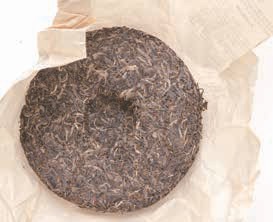
The discus ages better than other shapes. Traditionally, they were 357grams. However, nowadays they can be as small as 100g and as large as 1or even 5kg. Those compressed using the traditional stone mold will be looser. Some bings are compressed very tightly. Those are called "iron discuss (tie bing, 鐵餅)".

These open, nest-shaped cakes are usually smaller than bings. Traditionally, they were from 75g to 250g, and most commonly 100g or 150g. Nowadays, there are huge ones as well. In the old days, more buds were put in tuocha, making them sweeter. They are also compressed tighter, so they age slower.
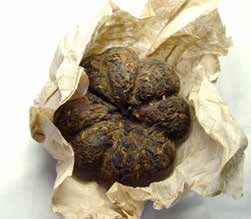
Like a tuocha, these are bowl-shaped cakes, only with ridges that make them look like a pumpkin or melon. This is one of the oldest shapes, often given to honored officials - even the emperor himself. They can be many sizes, and stacks of them, from larger to smaller, are often used to decorate shops and for good luck.
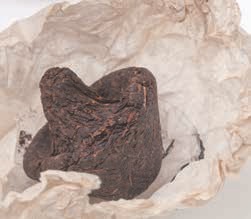
Mushroom cakes are typically 250grams. They were mostly exported to Tibet. The Chinese literally means "tight tea", but the words sound like heart in Tibetan. And the Tibetans found these cakes to be heart-shaped.
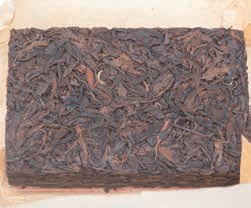
Bricks are also ancient shapes, and amongst the oldest teas ever found. Like mushrooms, they are almost always 250grams. There are smaller and larger ones in modern production. They are also usually tighter than bings.

These flat and square cakes aren't as old as other shapes. They are often 100-200g in size. Sometimes they have pictures or characters compressed into them for luck or decoration. They are always tight in compression, as they are machine-pressed.
Having a lot of information about puerh is no substitute for drinking these teas, and really only useful in purchasing tea, establishing or verifying a vintage or having discussions with connoisseurs. To us, Tea is medicine, and aged puerh teas hold the highest vibration. Puerh is magical in its ability to connect us with ourselves, Mother Earth and each other. It is stronger and more vibrant than most other teas. We hope to cover Tea from many perspectives in these pages, including linear information about tea, tea production, history and culture. But these are not so worthwhile without experience. What would books of tea information be without any tea to drink? Consequently, be sure to temper all this left brain with some right, all this mind with some spirit - all these tea words with some tea wisdom!
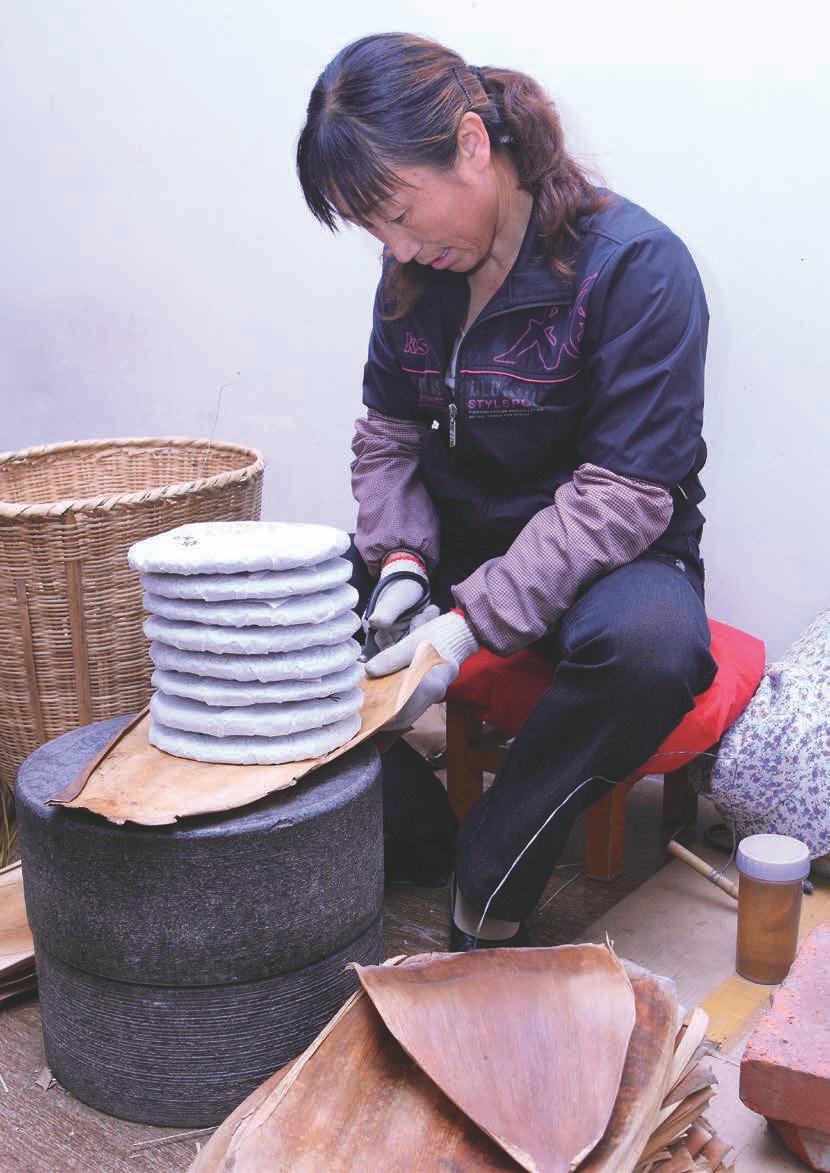
"I'm using bamboo bark to wrap seven cakes up into tongs. This is a very old tradition. The bamboo bark helps protect the tea from the elements and humidity, and lends it a nice fragrance as well. The bamboo has good energy."